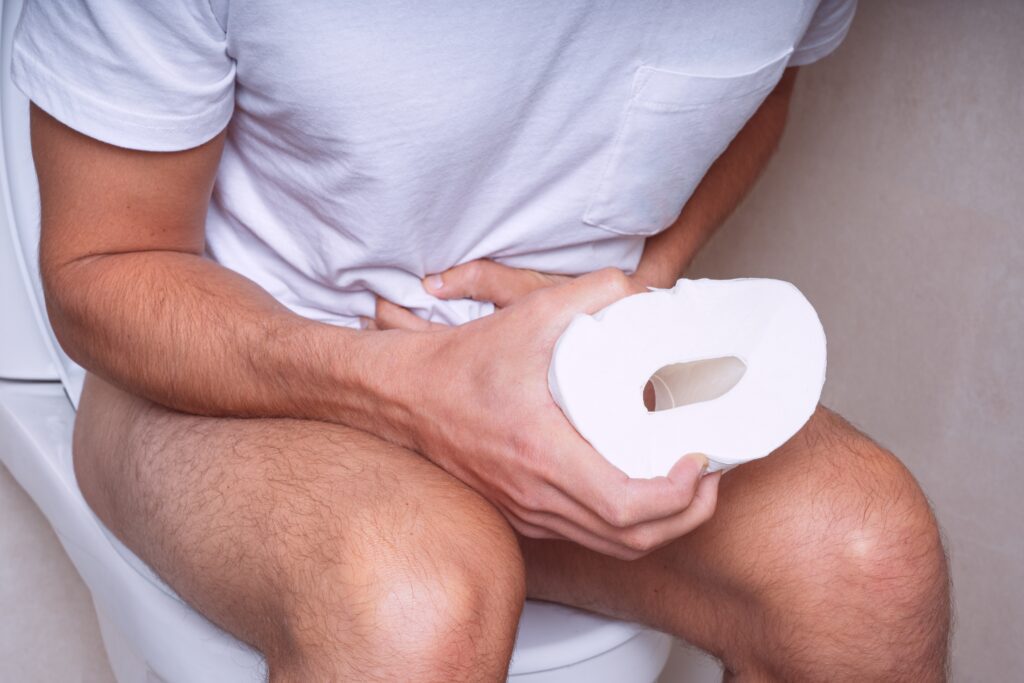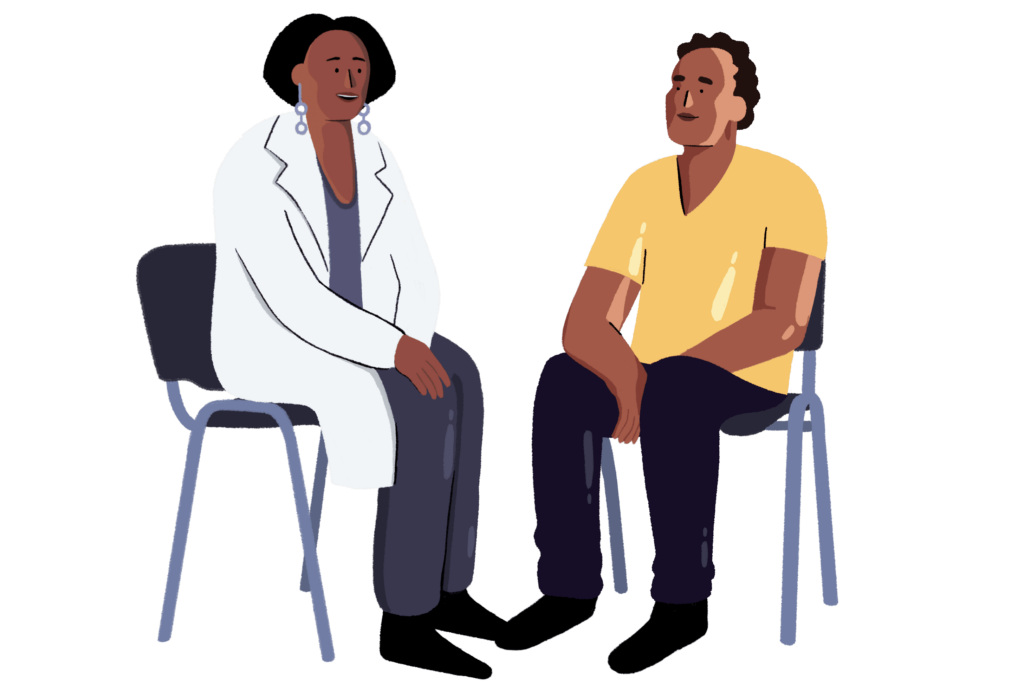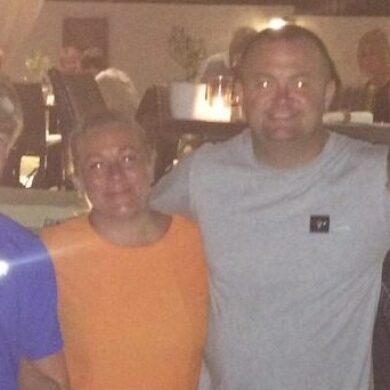Bile Acid Diarrhoea
Download printable versionOverview
Bile is a substance produced by the liver. Bile contains bile acids which have two main purposes.
They are:
- To break down food as it passes through the gut. This helps fats and fat-soluble vitamins to pass into the body.
- To aid with the removal of waste products.

Bile acids are made in the liver and stored in the gallbladder. When we eat food, they are released into the top of the small bowel. They help absorb fats from food. Most bile acids are then taken back into the body in the last section of the small bowel (the ileum). The bile acids are then returned to the liver. This cycle is called the enterohepatic circulation. Only a small amount usually passes into the large intestine and then is lost in the stool (faeces, poo).
When bile acids are not absorbed so well (malabsorption), or when an excess is produced, more bile acids in the large intestine cause bile acid diarrhoea. You may see bile acid diarrhoea called bile acid malabsorption or bile salt malabsorption. All terms describe the same disorder. Bile acid diarrhoea affects up to 1 in 100 people in the UK. This is the same as 1 person being diagnosed in a small village.
Causes
There are three types of bile acid diarrhoea. These are grouped into types:
Type I.
This is when there is a problem in the last part of the small bowel (ileum) where bile is taken back into circulation. Causes include when that part of the bowel is removed by surgery. It also happens when the area is inflamed. This due to conditions such as Crohn’s disease or cancer treatment.
Type II.
This is when no definitive cause is found. This is called primary bile acid diarrhoea. However, it is not true malabsorption. It is caused by an overproduction of bile. More bile is produced than can be absorbed by the small bowel.
Type III.
This is when other diseases in the belly (abdomen) can cause bile acid diarrhoea. Examples are:
- Gallbladder removal.
- Radiotherapy or chemotherapy. More than 1 in 2 people having these treatments might have this condition.
- Small bowel bacterial overgrowth.
- Bariatric surgery·
Symptoms
Diarrhoea: This is the main symptom. When bile acids are not re-absorbed from the small bowel they pass into the large bowel. This causes the body to release salt and water into the large bowel. The result is diarrhoea or loose, unformed stools which need to be passed more frequently during the day. It may be pale, greasy and hard to flush away. Plus, it may be green, yellow or orange in colour.
Sometimes people are woken from sleep to empty their bowel. They also have particular problems with urgency when they have to go to the toilet very quickly and many experience incontinence episodes.

Other digestive or abdominal problems may include, bloating, cramping abdominal pain and excessive smelly wind.
People also have reported feeling sick. Another reported symptom is tiredness.
The symptoms of bile acid diarrhoea and irritable bowel syndrome (IBS) are alike. Many people with IBS have diarrhoea symptoms. 1 in 3 of those people may have undiagnosed bile acid diarrhoea.
Diagnosis
The main test for a diagnosis of bile acid diarrhoea is called a SeHCAT scan. The nuclear medicine department perform the test. You will be asked to swallow a capsule or a drink. The capsule or drink contains an artificial bile acid. This is called SeHCAT and it contains a tiny amount of radiation. A first scan may be performed on the same day to find out how much artificial bile acid is in the body. This is the starting amount. One week later a second scan will show how much has been kept in the body and how much bile acid has been lost from the body. The amount of radiation in the test is very small and extra precautions are not needed.

Doctors sometimes may recommend going straight to a trial of treatment. The accepted test is the SeHCAT scan, which can predict how likely you are to respond to treatment. The National Institute of Clinical Excellence (NICE) reported some guidance. It said that some more research is needed into the use of the SeHCAT test but departments providing the test can continue to use it now. Guidelines from gastroenterologists advise its use. The test is only available for specialists to request. So, if you think you might have bile acid diarrhoea, you will need a referral to a gastroenterologist. Your GP can refer you.
Treatment
Treatment includes medicines. Treating the underlying cause can help if bile acid diarrhoea results from another cause (type I or III).
Medicines
These work by binding to the bile acid in the small intestine. This prevents them from causing symptoms in the large bowel. ‘Bile acid sequestrants’ is the term used for them. They are also known as bile acid binders.
They can help reduce the symptoms of frequency, urgency and give more formed stools. They must be taken four hours before or one hour after other medicines. This is because they can affect how the other medicine is taken into the body.
The main medications include:
- Colestyramine. This only comes in powder form which some people may find unpalatable. If the dose is too high, it can cause constipation and sometimes nausea or abdominal discomfort. 1 in 10 people might have these side effects. This number is like one person in your family having this symptom. It is important to adjust the dose according to symptoms. Your doctor or pharmacist can advise you. Colestipol is a similar powder but is not currently available.
- Colesevelam. This is a newer medicine, and it comes in a tablet form. Some people find it easier to take than colestyramine. Due to current cost and how it is licensed for use it may not be available everywhere. If a consultant recommends its use, it can be prescribed. This is done by a shared care agreement. The agreement is between the hospital and the GP service.
- Loperamide. This medicine can be used with bile acid sequestrants. It helps manage symptoms.
Research is being done on some newer medicines including liraglutide, a diabetes medication, and others used in different conditions. These are not currently available for use in people with bile acid diarrhoea.
Diet
Many people report that their symptoms are worse after fatty, rich meals, or certain foods containing FODMAPs (foods that in some people cause more wind and bloating). There is not enough evidence to support a single specific diet. More research is needed to find out which diet treatments might help people with the condition. Some people find following a low-fat diet helpful and this may be advised by your doctor. This is because, whilst there is little research done, doctors have clinical experience that it helps. Keeping a food symptom diary can help highlight trigger foods/drinks.
Some people might experience weight gain. If you have lost weight, it is important that you track this. You should let your GP know about any unplanned weight loss or if you are being restrictive with your diet. A dietitian might advise you on any changes to your weight or support you if you are removing foods from your diet. Ask your doctor for a referral.
Treatment usually improves the quality of lives of people with bile acid diarrhoea.

Does bile acid diarrhoea need to be monitored?
Medicines used to treat bile acid diarrhoea potentially may have some side effects. This may include lowering the levels of some fat-soluble vitamins (A, D, E and K). This is because the medicines can block how the vitamins are taken into the body. These types of medicines can often be used to help lower cholesterol too. Lowering cholesterol can increase triglycerides. Triglycerides are different sorts of fats in the blood. You might need blood tests to check your health. The tests check triglyceride and vitamin levels while taking the medicine.
It may be helpful to keep a note of stool frequency and consistency on a chart. A chart can tell the doctor how well symptoms are controlled. This helps to see when doses of medication might need adjusting.

Support
This can happen in several ways. Bile acid diarrhoea can affect you in several ways and can affect your daily routines to a great extend. The most common symptom is having diarrhoea often. The diarrhoea can occur 10 or more times a day. It may also lead to problems such as fear of leaving the house or travelling. Diarrhoea causes the body to lose too much bile acid. This raises the risk of gallstones. Other issues include medicine side effects.
The impact over time depends on the cause of your bile acid diarrhoea:
- People with Type I bile acid diarrhoea. The impact depends on if you had surgery to remove the last part of the small bowel, the ileum, or not. Plus, response to medication can be variable.
- People with Type II bile acid diarrhoea. Symptoms can improve over time and some people may not need medicine long term. Despite this, many people may need to remain on medications for a long term.
What to ask your doctor about bile acid diarrhoea?
- Do I need to be referred to a dietitian to prevent further weight loss?
- How often do I need blood tests?
- How do I adjust my medications according to my symptoms?
- How long will I need to take the medicine for?

What other organisations can help?
Bile acid diarrhoea can happen in people who have had surgery to remove their ileum. The ileum is the end part of the small bowel. This is called an ileal resection. This is usually for their Crohn’s disease, or they may have ileal inflammation. The IBD Relief website has useful information to help.
Research
Further research into diagnosing bile acid diarrhoea and the medications to help treat this is needed. More investigations into why the condition occurs is on-going, particularly the primary form. There is the potential for new hormone-based treatments in the future.
More research into the role of diet and lifestyle factors to help treat bile acid diarrhoea is needed.
Guts UK is the only UK charity funding research into the whole digestive system. Our vision is of a world where digestive diseases are better understood, better treated and where everyone who lives with one gets the support they need.
Help make our vision a reality with a donation to Guts UK today.DISCOVER MORE:
Copyright © 2025 Guts UK. This leaflet was published by Guts UK in November 2024 and will be reviewed in 2027. The leaflet was written by Guts UK and reviewed by experts in ulcerative colitis and has been subject to both lay and professional review. All content in this leaflet is for information only. The information in this leaflet is not a substitute for professional medical care by a qualified doctor or other healthcare professional. We currently use AI translation tools on our website, which may not always provide perfect translations. Please check for further explanation with your doctor if the information is unclear. ALWAYS check with your doctor if you have any concerns about your health, medical condition or treatment. The publishers are not responsible or liable, directly or indirectly, for any form of damages whatsoever resulting from the use (or misuse) of information contained or implied in this leaflet. Please contact Guts UK if you believe any information in this leaflet is in error.



